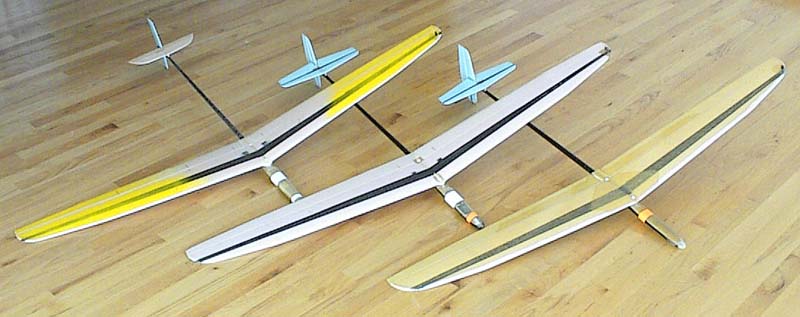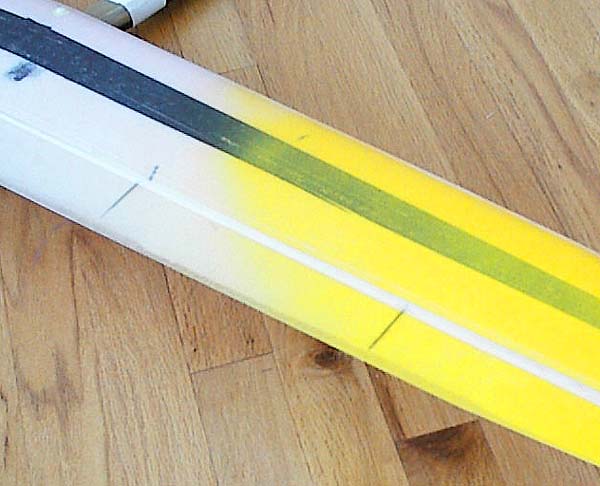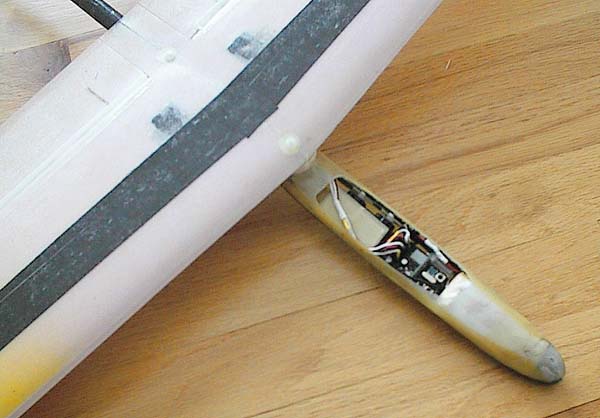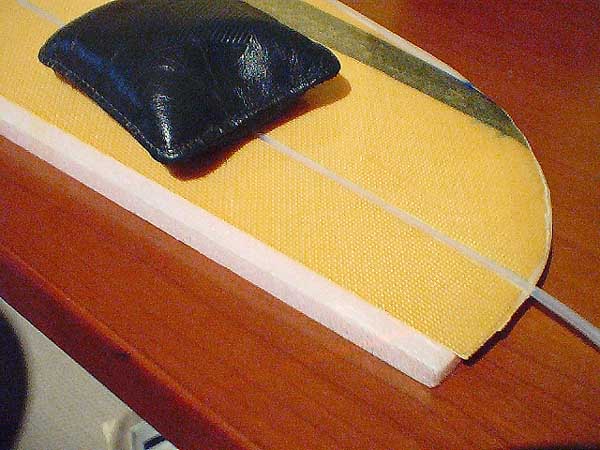
(design by Mark Drela)
Plans are here.

Whenever Dr. Drela publishes a RC glider design, the world stands up to take notice. Even if you do not build one of them, the design process, structural innovations and aerodynamic features are well worth considering in your own designs. Having built a never ending series of Spin Cycles, I decided that I would try a SuperGee, with a few changes based on personal experience. Note that these changes are not an attempt to improve on his design choices, but to accommodate my own ham handed building skills and available tools.
The obvious changes to the plane are:
Wing - I used pink foam cores not Spyder foam, I don't know where to get Spyder foam in Canada, and it's way too expensive to ship. The layup was changed to 1.4 oz fiberglass (FG) and bigger carbon fiber (CF) spars. The throwing tip has a 1/32" balsa shear web and the center joint also has CF reinforcement. The layup and reinforcements have been developed though the Spin Cycles and are plenty strong enough. The finished wings weigh only 5 grams more than the listed plan weight and are much cheaper to construct than a Spyder foam core with kevlar skins. Dihedral has been reduced to 4.5 degrees. Personal choice again, I have flown aileron ships with lots of dihedral and prefer the handling of a plane with almost no dihedral. A throwing peg made from a split CF arrow shaft is imbedded in the kevlar reinforced tip section, right at the spar.

The other issue with the FG skin instead of Kevlar is the right aileron stiffness to prevent flutter. In addition to facing the hinge slot with FG, I added stiffeners made from 0.010 CF. These do reduce the flex of the aileron a lot.

Fuselage - I really like the stiff Allegro style tailbooms on a DLG, they give improved launches and handling. With no ready source of Avia G-force SUL kite spars, I rolled my own tailboom from CF and bias FG. The boom weighs 22g and is 33" long. The pod is from the Spincycle as well but does not differ much from the plan. Note the 2 cell Tadiran pack, 6.8 V, 830 mah, that's good for about 6 hours of continuous flying with incredibly fast servo response.

Tail - I also like the longer tail booms for yaw damping based on my own experience, so the tail moment has been increased with an linear reduction in tail areas. The horizontal stab is a flat plate of 1/8" contest balsa. The fin is Dow Hi-Load 60 with the HT-23 section. This is the smallest core I have ever worked with. Both stabs are skinned with 0.73 oz FG sheared out to the maximum. Pull Pull lines are very light and reliable.

Final weight is a whopping 10.4 ounces, due to heavier radio gear (+22 grams), the fuse/pod (+16g), and wing (+5 grams). Reducing radio weight is meaningless since nose weight is required. The weight penalty really comes down to the choice of a stiff (heavy) tailboom. Even then, it's not within my ability to construct a plane at the listed plan specs, I would have likely gained at least 10% on each part. For instance, I don't have the skill or patience to hand shape the tail cores before bagging. Besides, I have a poly floater for when conditions are light.
Launching
March 19, 2002. Oh the weather outside is frightful... -18 C (0 F) but no wind. Air density correction for the temperature means we are flying at sub-sea level except absolute humidity is zero. Hmmm, the Reynolds Number change due to density and viscosity is #$%@$#, ah forget it, just fly the plane and worry about the batteries..
Day 1 - I set up the plane at the plan CG and an estimated 2 degrees of positive incidence on the stab. A light overhand toss shows the trim is stable enough to fly. A half hearted discus launch and the plane climbs out in a half loop. A few clicks of down trim doesn't help, the CG is too far forward and starting a HLG flight inverted gets no style points. Chop off the stab pylon and take out 1.5 degrees of incidence and move the CG back 1/8". On to day 2.
Day 2 - OK, the plane is launching straight up after a good transition. The launch phases will now have to be programmed into the Stylus. Phase One is slight right rudder (just tension the pull-pull line to prevent rudder flex), camber on the wing and enough elevator preset to get the climb started. Phase Two - reflex camber to reduce the drag when going straight up, no elevator and no rudder. Phase 3 - push over to normal flight and camber for normal cruise (+1 degree droop from reflex position). Cripes, this is gonna take some switch flipping while spinning round. The plane goes absolutely dead straight on launch with this setup, and it looks like superior energy retention in the initial part of the climb. Hats off to the cambered fin and stiff boom. Launches are vertical with a transition that is hard to believe, I attribute the short transition to the immediate damping of the yaw component, preventing weird plane attitudes after release.
For you Stylus users, the Launch switch is on #15, and Reflex is #17. Also programmed to switch #15 is Auto-Offset on the rudder. At the start of the throw, switch positions are 15 and 17, but Launch mode overrides Reflex mode so the flaps are cambered. Throw the plane and let go of #15 after transition to vertical, Reflex mode becomes active. At the top of the launch, the index finger flicks # 17 to either #18 or 19 and you're in normal mode. All you have to remember is that Reflex is towards you on the 3 way switch. When setting up the plane, put active elevator trims on VR 9 and VR 10, then lock once you are happy.
Flying - Looks like the 4.5 degrees of dihedral is fine for my taste, you can do nice axial rolls on the approach. Trimming for maximum float will take a dead air day and lots of camber testing. Even at 10.5 ounces the hang is quite good with max camber dialed in. I can only imagine how well a 8.3 oz. plane would hang.
Update April, 2002 - After thinking about the effect of dihedral angle (BTW the 4.5 degrees is 2.25 per side) I decided to build one with the recommended 14 degrees of dihedral. Seven degrees of EDA calculates out at a spiral stability coefficient of 4.65, this should be almost exactly stable. The intent will be to set up thermal turns with the ailerons, dial in the camber and fly the thermal with the rudder. By minimizing aileron inputs, the airfoil camber will stay within the high performance envelope which should reduce the sink rate. This is the way that the Encore is designed to be flown. I am also concerned about the loss in launch height due to yaw/roll coupling on release, the additional drag of the correction is noticeable on the poly DLGs. Click to enlarge the pictures below:
This plane is being built as light as possible, the boom is 11.4 grams, the bare wing is 112.3g, the tails are 12.8 g. I have also shortened the tail to the plan size, but reduced the rudder to 26 sq.in. This should balance the plane without any nose weight. With the usual radio gear, the all up weight is 9.2 oz. A serious sacrifice was made to the boom strength, we shall see if the boom will last. (It has.)
To really stiffen up the ailerons, pre-cured fiberglass was used as facing on the cutouts. A strip of four layer 1.4 ounce bias FG was securely glued to the foam face using a stiff microballoon mix, a teflon tube was jammed into the slot to press the cured FG strip against the foam face. The pre-cured FG is conveniently available from the trailing edge trimmings. Total weight added is 2.35 grams and these really make a difference. Neither plane has fluttered on launch but I doubt that an un-reinforced aileron would be stiff enough.
The additional weight savings have come from a reduction in the wire gages, using 110 ni-cad batteries, and a lighter pod. The horizontal stab airfoil is the HT-13, I had the templates around so it was easier to use. According to plan, the peg is no longer a tube, it is a strip of pre-cured 0.060 CF with an airfoil shape. Even with a fully rounded trailing edge on the peg, it still is painful on the fingertips. Fortunately you do not have to throw the plane very often!
Flying comparison - even after 1 hour of flying, it's obvious that the increased dihedral and lower weight is a big help in flying tight thermal circles. The plane is stable in a 20 foot diameter thermal turn with only up elevator, no tendency to tuck in. I would highly endorse the 7 degrees as a better plane. Launch height seem to be slightly less though the reduced weight may be the cause of that. Slightly more rudder preset is needed on the initial transition and the plane does have more of a tendency to be rotated off axis during the vertical part of the launch, i.e. it is more difficult to launch and pop over the top directly into the wind.
Plane #1 is 10.4 ounces and has 4.5 degrees of dihedral. Plane #2 is 9.2 ounces (260.4g) and has 14 degrees of dihedral (7 per side). My conclusion is that this plane needs to built very light (under 9 oz) to get the maximum performance, unlike some of my other DLG's which are indifferent to being 1 to 1.5 ounces heavy. The second planeís float is very, very good, and the thermal turning radius is tiny. Extrapolating the performance for another 10% reduction is weight would put the performance beyond anything I have seen.
A little weight analysis is in order. Plane #2 is 28 grams over target weight. Using FG wing layups and fuselages that will withstand launching and the occasional cartwheel, I cannot build a plane robust enough to withstand constant use at under 9.0 ounces. The 2nd wing came out at 135.7g with servos (JR 241ís), wiring and hardware. The target weight is 136.5 so all my fat is in the fuse and tail. The tail is 1.1 grams over target, plus this would add another 3.3 in the nose. The HS-55ís add another 3.5 grams; going to NiMH batteries saves another 8 grams. The remainder is in the fuse pod, I do not like to snap a pod on a slightly muffed landing and weaker pod layups have failed after a few hundred flights, primarily due to side load on the launch. I have a Feather XL fuse pod which weighs under 0.5 ounces and had to be reinforced. Given that the plane balances without nose weight, the nose moment would also have to be extended and the pod would be very squishy. So I can make the wing weight but not the boom and pod. Note that the last tailboom is stiff but weighs less that the Avia G-force SUL so that is not a compromise.
If you are thinking about building one of these, keep it light, put in the large dihedral and go with a stiff boom.
The Supergee #2 has lasted a full season. This is remarkable you see, because I fly at least 2 to 8 hours per week in my yard. Sometimes it's launch and catch practice, sometimes I spec out for 30 minutes in one throw. The only mishap was a hard landing in gusty winds that creased one side of the rudder. This was fixed with minimal weight gain and no effect on flying. The LE next to the pylon has become worn due to hundreds of hand catches, so a small strip of FG has been added to prevent denting. Model #1 is only used in winds over 10 mph since it is pre-ballasted.
There has been little development in DLG's over the last year, and the building season requires that I build at least one more. Since the design has proven itself to be a good performer, this one will be made from Kevlar for durability. Calculations show that not much weight will be gained over my FG skin models since the doublers can be smaller and the aileron layup can be reduced. One ounce Kevlar is far too expensive, so 1.7 oz will be used overall on the wing skins. A extra lightweight pod and boom, lighter shell but more carbon, has been built which comes in a 9 grams lighter. This plane should be under 9 ounces with 4 servos.

This picture shows the Kevlar skinned wing out of the bag and before trimming the TE. Though the plans do not show the partial aileron doublers, the Aegea plans do, and it will improve the flutter resistance of the ailerons. I'm using 2.9 oz. Uni-CF spars with a 1/32 contest balsa shear web in the throwing wing. The wings weigh 113.4 grams at this point (after trimming the TE). For those who have not tried, the bagging of these wings is very tedious. Each piece of the skin layup must be precisely cut and positioned exactly to line up with the foam core. I had so many positioning marks on the Mylars it was starting to get confusing. Adding the hard points for the wing mounting bolts and throwing peg before bagging gives a smoother finish.

This picture shows the aileron hinge slot, and the FG facing being applied. A teflon tube is in the slot holding the FG strip against the foam face of the aileron. There's a write up of the method in the Yahoo SAL glider group. Since Kevlar does not like to be routered, the slot was cut by hand using a metal ruler taped to the wing. Just a little more work but still an acceptable result. Do not twist the aileron by jamming the Teflon tube in too hard, it's best to have the wings on their core beds and weigh the wing flat along the hinge line. Any warp can be removed by removing the tube, holding the wing flat and dribbling hot water into the hinge slot.
And here's the final mass tally:
| Item | Mass (g) |
|---|---|
| Cores | 34.1 |
| Shear web & CF rod | 2.5 |
| Skin & reinforcing | 75.8 |
| Aileron facings | 2.5 |
| Horns | 1.1 |
| Pushrods | 2.1 |
| Total wing | 118.1 |
| Pod | 18.4 |
| Boom | 11.8 |
| Rudder | 6.0 |
| Elevator | 6.1 |
| Wing blocks | 0.9 |
| Pushrods | 4.0 |
| Wing pylon grout | 1.7 |
| Canopy | 2.5 |
| Wing bolts | 0.8 |
| Total Fuselage | 52.2 |
| Radio | |
| Wing wire harness | 3.3 |
| Hitec 555 | 16.3 |
| 4X350 NiMH | 33.0 |
| JR241 (ail) | 18.4 |
| HS-50 | 12.2 |
| Nose weight | 0.9 |
| Total | 254.4 |
Yup, that's a total RTF weight of 8.97 ounces, so it made my target mass. The killer was the noseweight, my calcs on balance were off by that much Given that the Taboo XL and XP3's are coming in at 11 to 11.5 ounces, this is a serious advantage over the commercially available DLG's. The planes have gone from 10.3 to 9.2, to 9.0 ounces, extrapolating the trend says that the next plane will weigh 8.9 and that's it. With all of the templates, molds and fittings, the planes are taking about 40 hours from start to finish.
Alright, I'm done for a while with building hand launch planes, here's #4.

In an attempt to move the peg as far forward and outboard as possible, a layer of bias CF has been added to the LE. The peg is moved right to the edge of the wing on the spar.

Plane number 4 is for windy flying and a little more robust at 9.6 oz. Just to show how weight can creep up on your planes, the extra 16 grams(!) is due to the following: paint the wings (2.9g), wider LE Kevlar (0.9g), CF stiffener in the fin (0.3 plus 1 in the nose), stronger pod (3.0g), fatter boom with same wall thickness(1.1g) and a ballast tube (1.3g). The remainder is just variation in building tolerances. The 5/8" diameter ballast tube sits under the wing and can hold 26g (0.91 oz. or 9.5%) of weight to bring the plane up to 10.5 oz.
I have balanced all of my planes at 86mm from the LE. This corresponds to the neutral point of the MAC, in the dive test the planes do not pull out at all. The consistency on launching is improved when the plane is balanced aerodynamically through the transition and climb, very small presets (and low forces) are required. With the stiff booms, control response at high speed is not an issue.
Last update: Feb. 2003.
Return to RC Soaring
Copyright W. Man-Son-Hing 2002